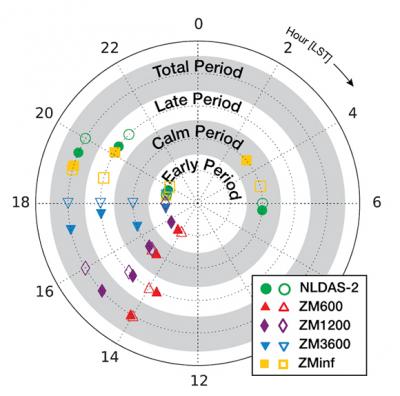Trading Off Climate Models' Issues
Using increased computing power, climate modelers divide Earth’s atmosphere into smaller areas so that global models can represent more details in the climate. But how do these large models behave with this higher resolution? Using a regional atmospheric model as a proxy for upcoming high-resolution global climate models, researchers at Pacific Northwest National Laboratory found that global models carry many biases into the higher resolution regional output despite its finer detail. The research identified certain tradeoffs that highlight modeling challenges when moving from coarse to high-resolution simulations.
“By extending the convective timescale to understand how quickly storm clouds impact the air around them, the model produced too little rain,” said Dr. William I. Gustafson, Jr., lead researcher and atmospheric scientist at PNNL. “When we used a shorter timescale it improved the rain amount but caused rain to occur too early in the day.”
For their investigation, PNNL researchers used the physics packages from the Community Atmosphere Model Version 5 (CAM5) in a regional model. This enabled them to combine higher resolutions with realistic weather conditions to determine if the simulated precipitation improved using higher resolutions.
The resulting paper is one in a series to examine the resolution dependence and behavior of the CAM5 physics suite within the Weather Research and Forecasting (WRF) model. Earlier work studied the resolution dependence of the cloud microphysics and the aerosol components. For this study, they focused on precipitation behavior and the Zhang-McFarlane deep convection parameterization combined with simulating the Midlatitude Continental Convective Clouds Experiment (MC3E) field campaign period (see sidebar, MC3E Campaign) over the central United States. The transition period between spring and summer exhibited weather conditions with strong contrasting local and large-scale effects. By breaking the period into sub-periods, they examined how the precipitation behavior changed based on the meteorological conditions.
At the community level—what climate modelers describe as the regional scale—is where climate change matters most to businesses, citizenry and policy makers. This level of detail will require higher resolution models that are able to depict small-scale features—such as rain, snow, and cloud cover. Researchers also expect higher resolution will lead to overall improved accuracy of large-scale climate simulations. In anticipation of the global models using a high resolution within the next couple years, researchers in this study tested a common method’s behavior when used at higher resolution. In this way, researchers are improving today’s methodologies to prepare for the next generation climate models.
The authors thank Matus Martini, Yun Qian, Philip Rasch, Heng Xiao, and the reviewers for their input on this manuscript and Huiping Yan for sharing code to calculate precipitation diurnal cycle. Funding for this work has been provided by a U.S. Department of Energy (DOE) Early Career grant awarded to Dr. Gustafson with additional funding from DOE's Office of Science/Biological and Environmental Research, through the Earth System Modeling Program (“Interactions of Aerosol, Clouds, and Precipitation in the Climate System” Science Focus Area) and the Aerosol Climate Initiative within the Laboratory Directed Research and Development (LDRD) program at the Pacific Northwest National Laboratory (PNNL). A portion of the research was performed using PNNL Institutional Computing. Battelle Memorial Institute operates PNNL under contract DE-AC05-76RL01830. NLDAS-2 data used in this study were acquired as part of the mission of NASA's Earth Science Division and archived and distributed by the Goddard Earth Sciences Data and Information Services Center. CSSEFARMBE data were provided by Laura Riihimaki at PNNL and is also available from the Earth System Grid Federation via http://dev.esg.anl.gov/esgf-web-fe/live. GFS analyses were obtained from the National Climatic Data Center at http://nomads.ncdc.noaa.gov/data.php-hires_weather_datasets. Additional data were obtained from the Atmospheric Radiation Measurement (ARM) Program sponsored by the U.S. Department of Energy, Office of Science, Office of Biological and Environmental Research, Earth and Environmental Systems Sciences Division.


